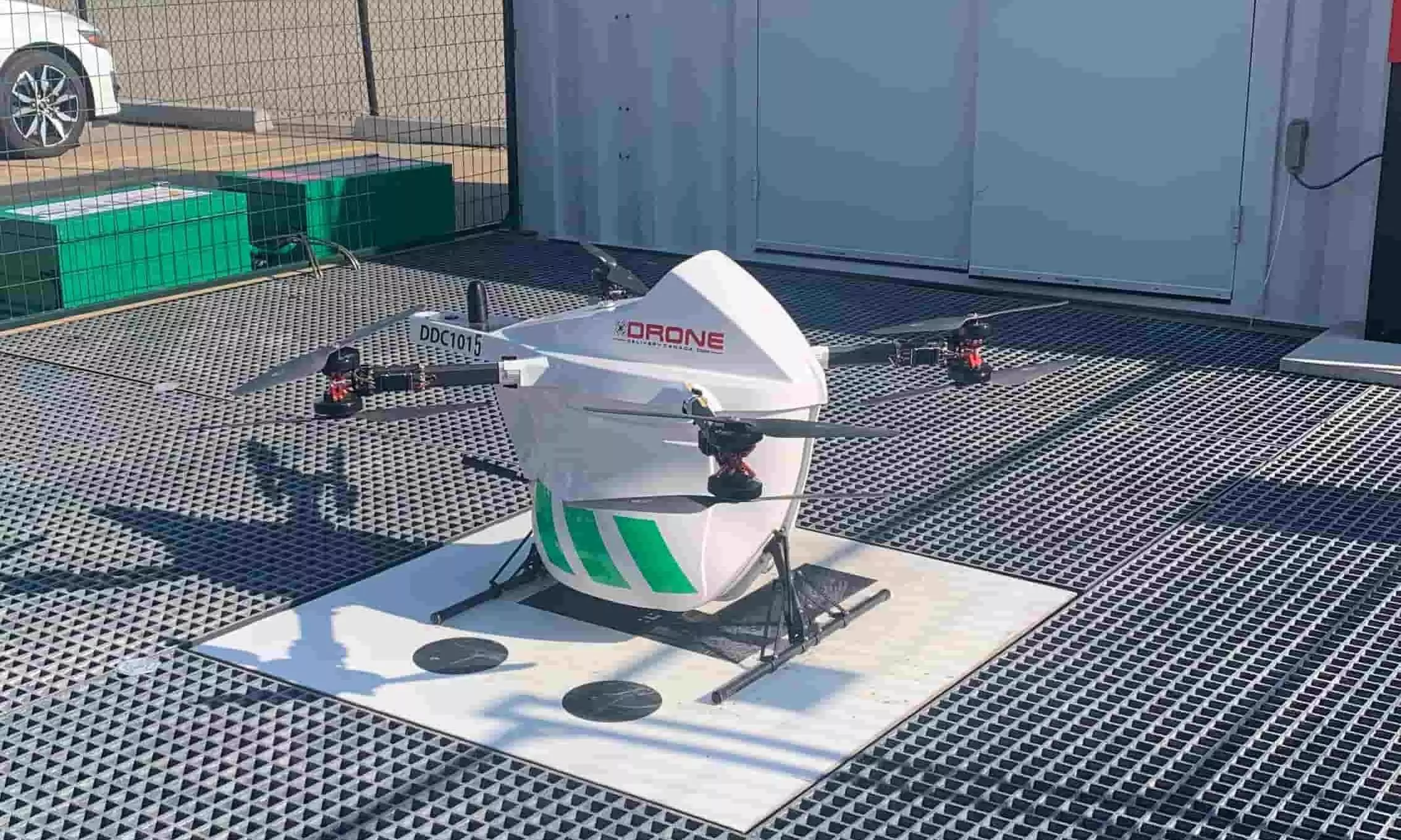
How drones are revolutionising air cargo sustainability
Drones are revolutionising air cargo by offering faster, cleaner, and more cost-efficient delivery—cutting emissions, easing road congestion, and reshaping the future of sustainable logistics.

In 2025, drones are rapidly reshaping global logistics—offering a cleaner, faster alternative to congested roads and outdated infrastructure. Once seen as experimental, drones are now central to building more agile and sustainable supply chains. From delivering medical supplies to remote clinics to dropping e-commerce parcels on city rooftops, unmanned aerial vehicles (UAVs) are changing how goods move.
With rising pressure to reduce emissions and improve delivery speeds, drones present a compelling solution: they’re efficient, scalable, and untethered from strained road networks.
“Every one of these deliveries relies on infrastructure that's a hundred years old. It's slow, expensive, and terrible for the environment,” says Keller Rinaudo Clifton, CEO and Co-founder of Zipline. “With a better system in place, one that's actually built for the 21st century, we believe the demand for delivery will grow by another 100x. But we don't have 100 times more humans to drive cars all day. Our roads can't handle 100 times more traffic. And the last thing our planet needs is 100 times more pollution.”
While EVs offer some relief, drones offer a more scalable and future-ready alternative.
Economics of the skies: Why drones make sense
One of the most persistent myths about drone logistics is that it's prohibitively expensive. In truth, the opposite is increasingly the case. As technology matures and operations scale, drones are proving to be both cost-effective and environmentally advantageous.
According to a study by Wipro, drone operations can reduce last-mile delivery costs by 40% to 70% compared to traditional vehicle-based services. The key drivers behind these savings include:
- Lower energy costs: Electric drones don’t rely on gasoline or diesel, drastically cutting fuel expenses.
- Reduced labour: Autonomous operations eliminate the need for drivers and reduce human resource requirements.
- Efficient routing: Drones fly directly to their destination, avoiding traffic and cutting down travel time.
- Minimal infrastructure strain: With no need for roads, drones avoid contributing to congestion or road wear and tear.
While the long-term savings are clear, the initial investment remains significant. Building a drone logistics network from scratch requires capital—drones, charging infrastructure, droneports, and regulatory navigation don’t come cheap. Unlike traditional logistics companies that can lean on existing fleets and facilities, drone operators are often creating entirely new ecosystems.
However, as operations scale and Beyond Visual Line of Sight (BVLOS) capabilities become standard, the economics shift favourably. The cost per delivery decreases, and the return on investment strengthens, especially in sectors where speed and reach are critical.
“Drones redefine what airports can do. We’re no longer just a hub for people and planes—we’re becoming integrated logistics ecosystems.”
Alex Lowe, YEG
Take Walmart, for example. The retail giant has rapidly expanded its drone delivery operations in the Dallas–Fort Worth area through partnerships with Zipline and Wing. Serving up to 1.8 million households, Walmart’s drones can deliver over 65,000 items—including groceries, over-the-counter medications, and household essentials—within 30 minutes. These zero-emission flights offer a compelling alternative to carbon-intensive van deliveries.
Amazon is pushing similar boundaries. Its Prime Air drones now operate in Texas and Arizona, with a target to deliver 500 million packages per year by 2030. These drones are engineered for BVLOS navigation and all-weather conditions. Amazon’s ambition dates back over a decade to when founder Jeff Bezos first unveiled the concept:
“We can carry objects up to five pounds, which covers 86% of the items we deliver. These are autonomous. You give them GPS coordinates, and they fly. All electric. Very green.”
That promise isn’t just a futuristic pitch—it’s a measurable impact. Drones offer a smarter, faster, and greener model for delivery logistics. As the regulatory environment matures and economies of scale kick in, the business case for drone delivery only gets stronger.
Emission reduction: Cleaner cargo from above
The environmental argument for drones is clear and compelling. The logistics industry contributes approximately 11% of global CO₂ emissions, with last-mile delivery accounting for up to 50% of delivery-related emissions in the US and Europe. Drones, with their electric powertrains and short, direct flight paths, offer a radically cleaner alternative.
Here’s how the numbers stack up:
- Zipline drones emit 99% less carbon than diesel vans and 94% less than electric delivery vehicles.
- Walmart’s drone program in the Dallas-Fort Worth area, which now reaches 1.8 million homes, results in 94% fewer emissions than car-based deliveries.
- A McKinsey & Company report found that widespread drone adoption could cut last-mile emissions by up to 80%, especially in dense urban areas.
Guillaume Crozier, Chief Cargo Officer at dnata, underscored the indirect sustainability benefits as well:
“Drones help you actually to have real-time visibility of your inventory… Being lean and efficient is always good in terms of sustainability and energy management.”
With many drone systems running on electricity—and the global energy grid increasingly powered by renewables—the environmental upside is only growing.
Beyond the last mile: The rise of mid-mile drones
While much of the focus on drones has been on last-mile delivery, key developments are underway in mid-mile logistics—moving goods between warehouses, distribution centres, and regional hubs. One example is Dronamics, whose Black Swan cargo drone can carry up to 350 kg over 2,500 km without relying on major airports or complex infrastructure.
“Our infrastructure-light droneports mean we don’t need to rely on traditional logistics hubs. A 400-meter airstrip is enough,” said Svilen Rangelov, CEO and Co-founder of Dronamics.
In 2023, Dronamics signed a Letter of Intent with Aramex to begin operations in the UAE, with expansion planned to South Africa and Australia. Backed by the Strategic Development Fund, the partnership aims to offer same-day, long-range cargo delivery that is up to 80% faster, 50% cheaper, and 60% lower in emissions compared to traditional mid-mile freight transport.
Real-world impact: Global progress from Canada to India
Across the globe, drone cargo operations are already delivering real-world impact.
Edmonton International Airport (YEG) is leading Canada's drone logistics transformation. Since May 2022, YEG has partnered with Drone Delivery Canada (DDC) to integrate drones into its cargo operations across the airport and nearby regions. Focused on boosting efficiency in first-mile, mid-mile, and last-mile deliveries, the initiative has already completed over 3,000 drone flights, covering more than 8,400 kilometres.
“We're Canada’s first and, I believe, only airport where we've launched commercial drone operations,” said Alex Lowe, Manager of Innovation & Partnerships at YEG.
The airport’s drone program recently began delivering medical supplies to a First Nations medical clinic—flying through the glide path of an active runway, a Canadian first. It’s not just about efficiency; it’s about equity.
“All parties are investing with the goal of reducing the carbon footprint of the transportation of goods, in particular medical supplies to First Nations communities,” added Lowe.
In India, where rural and remote regions often lack reliable infrastructure, drones are leapfrogging road-based logistics entirely. On May 16, 2025, India Post—the government-operated national postal service—completed a landmark drone delivery from Karjat (elevation: 194 meters) to Matheran (800 meters), Maharashtra. In this test, an IIT Madras–incubated Indian drone startup—Amber Wings—carried a 9.8 kg postal bag across a 9.5 km aerial route in just 15 minutes, compared to a 90-minute road journey. This mid-mile delivery pilot—executed within two weeks of planning—signals a potential shift in India’s drone logistics, especially in terrain-challenged areas.
This wasn’t India Post’s first drone venture. Back in 2022, another Indian drone startup TechEagle teamed up with India Post to carry out deliveries across Gujarat’s Kutch region. Their hybrid-electric VertiplaneX3 drone completed a 46 km journey in under 30 minutes, carrying a 3 kg payload—delivering five times faster than traditional ground transport.
With government initiatives like these pilot tests, exhibitions like Drone Shakti and dedicated drone corridors, India is poised to become a global leader in drone-enabled sustainable logistics.
“Drones help you actually to have real-time visibility of your inventory… Being lean and efficient is always good in terms of sustainability and energy management.”Guillaume Crozier, dnata
Efficiency behind the scenes: Smarter supply chains
Sustainability isn’t just about emissions; it’s also about operational efficiency. Platforms like FLYTE, used by Drone Delivery Canada and Edmonton Airport, bring automation and precision to the entire logistics chain—with real-time tracking, temperature control, and paperless systems.
As Crozier from dnata explained, “We’ve transformed the process to be a paperless one… and that definitely has a good impact.”
Inventory drones used within warehouses are another silent game-changer. They enable faster stocktaking, reduce shrinkage, and allow for more predictive planning—all of which contribute to leaner, greener operations.
Navigating the skies: Regulatory challenges remain
Despite the progress, regulatory hurdles remain the biggest barrier to full-scale deployment. Most drone deliveries today occur within tightly controlled areas. For widespread adoption, global regulatory frameworks must support BVLOS operations, automated air traffic management, and standardised drone corridors.
Programs like the FAA’s UTM (Unmanned Traffic Management) and Europe’s U-Space initiative are promising steps. But until coordination improves, expansion will remain fragmented.
Taking sustainability to new heights
Drones are not just flying gadgets or futuristic luxuries—they are fast becoming essential infrastructure for the 21st-century supply chain. From lowering costs to slashing emissions, drones offer an unparalleled opportunity to reimagine air cargo as a force for sustainability and innovation.
As Alex Lowe aptly put it, “Drones redefine what airports can do. We’re no longer just a hub for people and planes—we’re becoming integrated logistics ecosystems.”
The air cargo industry has a rare opportunity to lead a paradigm shift—one that flies above the limitations of the past and toward a cleaner, smarter future. If done right, drones could do more than deliver packages—they could deliver on the promise of a sustainable planet.
To explore how air cargo is not just enabling timely delivery of critical goods from life-saving medicines to cross-border e-commerce parcels—but also driving sustainability through managing waste and adopting renewable energy among others—watch the YouTube series - Future of Transport by STAT Media Group and Edmonton International Airport (YEG).


